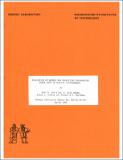| dc.contributor.author | Helfrich, Karl Richard | en_US |
| dc.contributor.other | Ralph M. Parsons Laboratory for Water Resources and Hydrodynamics. | en_US |
| dc.date.accessioned | 2011-01-14T22:42:29Z | |
| dc.date.available | 2011-01-14T22:42:29Z | |
| dc.date.issued | 1982 | en_US |
| dc.identifier.uri | http://hdl.handle.net/1721.1/60600 | |
| dc.description.abstract | Cooling impoundments can offer a number of advantages over cooling towers for condenser water cooling at steam electric power plants. However, a major disadvantage of cooling ponds is a lack of confidence in the ability to predict various aspects of their hydrothermal performance and consumptive water use. This report focuses on evaporation, which is related to both pond performance (temperatures) and consumptive water use. | en_US |
| dc.description.abstract | A discussion of evaporation equations from both a theoretical and an empirical basis is presented. Several empirical evaporation equations falling into three basic categories - Dalton Law, Modified Dalton Law and Stability Dependent - have been compared to determine accuracy and confidence limits for evaporation from heated water bodies. Comparisons have been carried out using MIT's dynamic cooling pond model MITEMP to evaluate the energy budget for six weeks of comprehensive meteorological and water temperature data taken at Dresden Cooling Pond in Illinois. Results show a large decrease in the variability among the different formulations (measured by mean error and variance of predicted and measured plant intake temperatures) when a dynamic model is used compared with the large variability among the equations for constant meteorological conditions and water surface temperature. Feedback between evaporation and temperature in the dynamic model is suggested as a reason for this decrease. Linear calibrations have been fitted to each equation using these data. The consistency of calibration was then checked using similar data from Powerton Cooling Pond in Illinois. Due to the high non-linearity of some of the equations, the effects of meteorological data averaging period are examined by long term simulations. | en_US |
| dc.description.abstract | Linearized surface heat loss formulations are discussed with emphasis on their use in long term forced evaporation water consumption estimates. An extension of the Harbeck Diagram concept (Harbeck, 1964; Ward, 1980) is presented to better account for non-linearities due to high temperature differences between heated and natural conditions. Surprisingly good agreement has been found between annual water consumption computed from diagram estimates and from dynamic hydrothermal model simulations involving full non-linear heat loss expressions. | en_US |
| dc.description.sponsorship | Electric Power Research Institute. | en_US |
| dc.format.extent | 165 p. in various pagings | en_US |
| dc.publisher | Cambridge, Mass. : Massachusetts Institute of Technology, Energy Laboratory, 1982 | en_US |
| dc.relation.ispartofseries | Energy Laboratory report (Massachusetts Institute of Technology. Energy Laboratory) no. MIT-EL 82-017. | en_US |
| dc.title | Evaluation of models for predicting evaporative water loss in cooling impoundments | en_US |
| dc.title.alternative | Cooling impoundments, Evaluation of models for predicting evaporative water loss in. | en_US |
| dc.identifier.oclc | 10716782 | en_US |
